- Home
- Thomas Cahill
Heretics and Heroes Page 22
Heretics and Heroes Read online
Page 22
It is not as if there had never before been innovators. All the major figures to appear in the earlier volumes of the Hinges of History—Patrick of Ireland, King David, the Hebrew chroniclers and prophets, Jesus, Paul, Socrates, Plato, Hildegard of Bingen, Eleanor of Aquitaine, Francis of Assisi, Giotto, Dante—were innovators. But in Columbus we meet not only innovation but self-invention and self-promotion of an entirely new sort. For better or worse, the personality of Columbus is an essential part of his story. This is also true of the stories of Lorenzo, Savonarola, Leonardo, Botticelli, Julius II, Michelangelo, Caravaggio, and Bernini. In these figures, attraction (and repulsion), fascination, and enchantment operate as they have never operated before. Whatever else these characters may have been, in their day they would all have made obvious candidates for cover stories in People magazine. Such a journalistic vehicle, utterly dependent on the spell cast by an individual, would not have been able to get enough of them. Indeed, though it is impossible to imagine our contemporary world without such journalistic phenomena as People, it is equally impossible to imagine such vehicles in the ancient or medieval worlds.
Those earlier societies lacked the invention of printing, which has surely assisted the exaltation of personality. But it hardly originated it. Personality cults were known in the ancient world, certainly as political phenomena. Think of Alexander the Great and Julius Caesar. But in the early modern period, a veritable culture of personality arises in Europe and the New World. The earliest figures, such as Torquemada, Ferdinand, and Isabella, seem somewhat intermediate characters, not as fully separate from their historical backgrounds, standing somewhere between the milder, more predictable figures of the Middle Ages and the astonishing new pop-up figures of the early modern period, more and more of them popping up from 1492 forward and all cutting spectacular figures in their day.
Nor does this breathtaking ascendancy of personality wane as we approach the Reformation. Was there ever a figure in history more attached to his subjective identity—to his “I”—than Martin Luther? As we approach the many characters in this unfolding drama, we shall find each of the reformers distinct and extraordinarily subjective. Their undying disagreements with one another tend to be the tags by which they are now remembered. In their own time, however, it was the individual force of each of their overwhelming Selves—the personal impact that each one exerted on his followers—that served as engines for the entire period.
As if to offer a visual confirmation of the assertions above, there is here presented for your enjoyment and edification a portfolio of portraits: Plates 30–53. Though there had been portraits in the classical period—we have a pretty good idea, for instance, of what Socrates, Plato, Alexander, and the Caesars looked like—we have none to speak of from the long Middle Ages. Hildegard’s portrait, perhaps even drawn by her, is just the Typical Nun. Similarly, the few appearances of Queen Eleanor in paint are of the Typical Queen. There may be one genuine likeness of Francis of Assisi, a homely little fellow painted by Cimabue; all the other dozens of depictions of Francis are simply the Typical Heroic Male Saint of the period.
But in the Renaissance and later, as Self ascended, so did portraiture, becoming the early modern equivalent of gossip columns and webcam videos. Bizarrely enough, these portraits will be almost the last burst of colorful visual art in this book. The reformers did not look kindly on the plastic arts, and not a few of them rejected all such art as a form of idolatry. (See the quotations from Deuteronomy, above, for their biblical warrant.) Nor would art survive in the Catholic world with the same sublimity and awe, or be cherished as it had formerly been. (See the quotation from Walter Pater on this page about reformed Catholicism’s incomprehension of the elderly Michelangelo; or see almost any Catholic church decorated after the Reformation, perhaps especially the gold-laden but dead churches of the new Jesuit order.)1
The majority of reformers went even further: they wished to destroy what art there was. They smashed the stained-glass windows; they lopped the heads off the statues; they scraped the paintings off the walls; they heaped the exquisitely wrought illuminated manuscripts on the bonfires. And, portraiture apart, they created only a few images of lasting significance.
1 Spectacular exceptions to the dead churches of the Counter-Reformation would include not a few Spanish mission churches in the Americas and, closer to our own time, the French chapels created by Le Corbusier (at Ronchamp) and by Matisse (at Vence). The mission churches are made lively by the pre-Christian sensibility of native American folk religion, the French chapels by post-Christian modernism.
V
PROTESTANT PICTURES
AND OTHER NORTHERN IMAGES
Doomsday is near; die all, die merrily.
Henry IV, Part 1
Between Luther’s visit to Rome in 1510–11 and 1610, when Galileo in Padua published Sidereus Nuncius (The Starry Messenger), his challenge to the theory of the geocentric universe, more seeds of change were planted in European soil than in any centenary period before the twentieth century. And even though the permanent effect of the northern (or German) Renaissance on the plastic arts would be fairly slight in comparison with the global remaking of human imagination effected by the Renaissance artists of Italy, it is worth our having a brief look at what the northerners, often prompted by Lutheran courage, accomplished in their smaller sphere of influence.
1498–1528: APOCALYPSE NOW
The strongest and most enduring manifestation of the Northern Renaissance, however, was not really dependent on Luther, for it is to be found in the images of Albrecht Dürer, many of which were known before Luther was even heard of. Despite many volumes of hot air blown by German critics attempting to exalt a passel of their artists, there is no one else like Dürer north of the Alps.1 He is in some respects the northern equivalent of Leonardo or Michelangelo, except for the fact that he stands alone and none of his Germanic fellows can cluster about him as do the many lesser lights of Italy about il Divino and his near equal.
In the years leading up to 1500, Christian Europe was full of babble about the imminent end of the world. It seemed so obvious: 1500 would be Earth’s last year, ushering in all the destructive events of the Apocalypse, as described in Apokalypsis Joannou, the Revelation of John the Divine, the Bible’s weird last book.2 The year 1000 had known somewhat similar excitement, though it had been confined to impressionable hysterics in the relatively small circles of those who could then read and count. By 1500, such circles had widened; and, as in our own day, those with the emptiest heads often have the most to squawk about.
Whether Dürer was gullible enough to take their squawking seriously (which I very much doubt), he was enterprising enough to take advantage of the excitement and ride it to fame. He contributed a series of fifteen woodcuts to a printed edition of Revelation. Readers found the large illustrations thrilling, and the illiterate were astonished at the pictures they held in their trembling hands. By 1500, the year of the anticipated apocalypse, Dürer had become famous throughout Germany, the first German artist to attain such renown. Soon enough, his fame, spread far and wide by the medium of printing, would make him the first pan-European artist, his name known to millions.
The woodcuts are wonderful, executed with a masterful sense of overall design, anatomical artfulness, and quirkily personal imagination. The most famous of the fifteen is the woodcut of The Four Horsemen, who, though they appear separately in the text of Revelation, are here shown sweeping over the world in concert, urged on by an angel from Heaven, Victory on the far right wielding his unbeatable Parthian bow, accompanied by War with his sword, Famine with his scales, and the pale figure of Death, riding an emaciated nag. In the lower left corner, the loathsome maw of Hell yawns, about to crush a crowned head in its fearsome teeth. The other victims—of lesser station, as their attire reveals—will soon slide toward those jaws of ultimate horror. So no one will escape the final accounting, neither king nor cottier.
(illustration credit 68)
(illustration credit 69)
The gruesomeness of apocalyptic retribution, wrought by nightmarish actors of convincing physicality, against identifiable contemporary figures—lords and commons such as anyone might encounter—seized the public and caused viewers to shudder at the horrifyingly thrilling possibility of the End Time. What if this were indeed about to happen? What if Frau Weibsbild down the lane is about to meet her awful last day along with millions of other unregenerate sinners, whilst I perhaps will be lifted up to Heaven with the elect? No creepy horror movie of our own time could have elicited more convincing yelps and yawls.
Another of the woodcuts depicts one of Revelation’s more puzzling scenes: “I heard a voice from the four horns3 of the golden altar which is before God, saying to the sixth angel which had the trumpet, ‘Loose the four angels which are bound in the great river Euphrates.’ And the four angels were loosed, which were prepared for an hour and a day and a month and a year, for to slay the third part of men.”
The four angels (I’m not sure anyone knows why these four had been previously bound in the Euphrates) are caught in the act of taking their vigorous exactions against one-third of humanity. You’ll note that the angel in the foreground is about to whack the pope, who wears his triply tiered papal tiara. Just behind His Holiness is the Holy Roman Emperor on the verge of receiving similar treatment. (The emperor sports the same mitered crown that then-emperor Maximilian I favored.) So, in 1498, almost two decades before Luther’s challenge, we have clear evidence that many Germans (and many Europeans beyond the German lands) would have been happy to see the pope lose his head and that virtually as many would have been content to see der römisch-deutsche Kaiser follow suit. However we may imagine what passed through the minds of the original viewers of these prints, however much we may attribute to them imaginative projections of their own deepest fears and desires, we can have no doubt that there was considerable public dissatisfaction with rulers, both sacred and profane. No one thought to upbraid Dürer for sending both pope and emperor to Hell. At the same time, it should be noted that it is the pope, not the emperor, who is in the foreground and that just behind him, indeed hovering at his backside as if in eternal sycophancy, is another bishop, wearing his miter of office. So, Dürer’s condemnation of papacy and church is more blatant than his condemnation of the civil power.4
Over the course of the fifteen prints, Dürer exhibits a graceful ease with the bizarre and unlikely figures that inhabit Revelation. If he is very good at capturing the heroically muscular action of the heavenly figures, he may be even better at depicting Gothic horrors. The nightmarish denizens of Hell have never found an abler portraitist. And the stark simplicity of black-and-white design has never found an abler dramatist. The depiction of the “war in Heaven” between the angelic forces of Saint Michael and the “great dragon” and his angels has an unforgettable visual force. The vigorous heavenly soldiers will win, no doubt. But even Saint Michael’s elongated and thrust weapon draws us visually to the great dragon—the Devil—and his horrific allies. Behind them the sky is dark, a series of simple horizontal lines. Below, by contrast, we see the lightsome and sweetly settled human communities of Earth in communion with nature, the ships in the harbor giving evidence of far-flung human communication. And yet, catastrophe is but a moment away: “Woe to the inhabiters of the Earth and of the sea! For the Devil is come down unto you [having been expelled from Heaven], having great wrath, because he knoweth that he hath but a short time.”
The starkness of the black-and-white medium of print only emphasizes the distance between Italian and northern European art. Dürer spent several years in Italy, absorbing everything he could of the Italian masters. His unerring sense of the drama of anatomy, movement, and layout shows what a keen student he was; and the examples of his art that survive from his pre-Italian period can be a trifle poky by comparison. Nonetheless, there are aspects of Dürer that, like Luther’s worst fantasies, derive their power from the nightmares of comfortless, endless northern winters and from the gloom of Germanic folktales, haunted by witches and goblins, not from the long, leafy, sun-drenched summers of Greco-Roman civilization, populated by nymphs and fauns.5
(illustration credit 70)
(illustration credit 71)
Despite all that Dürer learned in his lengthy Italian wanderings, he was never a mere imitator but always rooted in authentic northernness. Soon after his first Italian journey in 1494, he made one of his scariest, least Italian engravings, Junge Frau, vom Tode bedroht (Young Woman Attacked by Death) or Der Gewalttätige (The Rapist), in which the rapist Death rips the skirt of a young woman seated on his lap while she struggles to escape. It is a macabre variant on the many sketches of courting couples that were popular at the time—and it is one of the few prints of Dürer that lack his customary ad logo, which, in the absence of copyright laws, provided an assertion of ownership. Leonardo might not have cared for the face of Death, but the Brothers Grimm surely would have.
(Speaking of Leonardo, I am reminded that we stopped in Chapter II at his exceedingly famous image of the Vitruvian Man. But Dürer made an image that remains even more omnipresent: the Praying Hands, so recognizable that there is no need to reproduce it here. Two other images drawn by Dürer, however, are perhaps just a tad less well known than the Vitruvian Man: the humble Hare and the stupendous Rhinoceros, an animal never seen by Dürer. He created his attention-grabbing broadsheet using descriptions received by Nuremberg merchants from eyewitnesses in Lisbon harbor, where the first rhino to set hoof on European soil made for excited conversation.)
(illustration credit 72)
(illustration credit 73)
(illustration credit 74)
(illustration credit 75)
At the same time, it would be caricature to present Dürer as a fear-obsessed northerner, hounded by nightmares. His profound understanding of what the Italians had accomplished issues in some of his most treasured images, such as his engraving The Fall of Man (facing page, top), as deft and deep as anything by Michelangelo, especially if one views not just this black-and-white version, but Dürer’s exquisitely modeled and delicately colored oils of the same subject, twin panels hanging in the Prado, Madrid, and almost impossible to reprint successfully.
Dürer celebrated not only the ideal human body but every quotidian reality he could capture with his artist’s tools. His marvelous picture of the Prodigal Son (Luke 15:11–32), feeding the pigs on his master’s farm while kneeling in the muck and praying for a better alternative, contains, by the by, an exactingly detailed picture of an indifferently maintained German farmyard with its multiplicity of barns and dwellings and, beyond these, the roofs and chimneys of a town, including, on the far right, the turrets and steeples of a church, toward which the Prodigal directs his prayer (facing page, bottom).
Similarly, a much later engraving by Dürer (see next page, top) shows a dancing peasant couple in all their glorious ordinariness, the woman with her keys and other symbols of responsibility dangling from her waist, the man ineffectively shod, his left sleeve ripped at the elbow. They are neither ideal nor especially admirable; they may be cunning, but they are not intelligent. They are vulnerable human beings, having fun. Give them a break. Scenes such as this and The Prodigal Son open the door to the so-called genre painting of northern Europe, especially to such extraordinary (and extraordinarily sympathetic) artists of ordinary life as Bruegel the Elder and Vermeer.
Occasionally, Dürer tried to crisscross the Italianate with the Germanic—to comic effect. One example is the engraving of Nemesis, the Greek goddess of Fate, who had never been depicted by the Greeks or by anyone else (see next page, bottom left). It turns out she looks like a naked middle-aged German frau, whooshing over the South Tyrol on her personal sphere. In her left hand, she holds a bridle and reins, symbolic of her intention to impose discipline. In her right, she offers a Gothic goblet, symbolic of her willingness to reward those who submit to her discipline. Beneath the cloud
s are the beautiful settlements of the Isarco Valley, whose inhabitants speak Italian as well as German. This goddess is not as awful as she might be, but she’s no Venus, boys. There seems to be a not-so-hidden commentary here on German women, as contrasted with the genuine goddesses of Italy. Perhaps I read too much into this, but we know that Dürer’s arranged marriage was an unhappy one and that he took off for Italy whenever he could get away.
(illustration credit 76)
(illustration credit 77)
(illustration credit 78)
In addition to Dürer’s astonishing self-portrait as Christ [second insert, Plate 36], Dürer made almost as many self-portraits as Rembrandt would, none more incredible than the one he made when he was thirteen, surely the earliest worthy self-portrait ever made, before or since. The confidence of this boy was amazing.
Dürer painted himself as a jaunty man-about-town two years before his Christ portrait and as an edgy Christ in his Passion more than two decades later—in 1522, just six years prior to his own death. But perhaps the most unexpected self-portrait is the pen-and-brush image on green grounded paper that Dürer made in 1505 (facing page, bottom right), just three years after his self-portrait as the handsome, curly-haired Christ. Here is surely a revelation: a man from head to knees, watchful, almost anxious, without curls and completely nude, his genitals, as Joseph Leo Koerner has remarked, “the most particularized area of the sketch, displaying an irregularity and profile distinctly their own.”6 This was a playful man who nonetheless wanted complete honesty, not facile idealization.

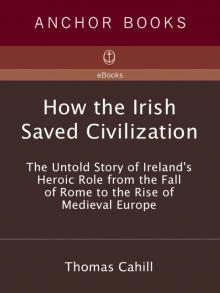 How the Irish Saved Civilization
How the Irish Saved Civilization The Gifts of the Jews
The Gifts of the Jews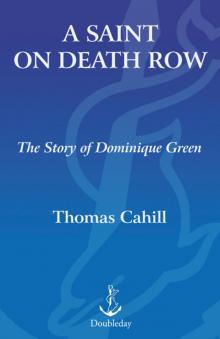 A Saint on Death Row
A Saint on Death Row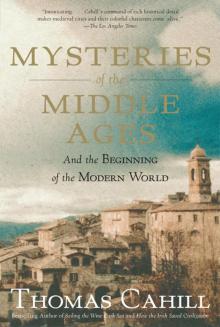 Mysteries of the Middle Ages
Mysteries of the Middle Ages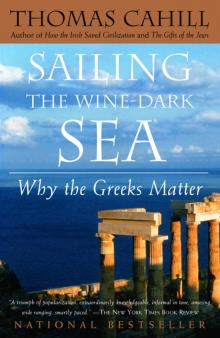 Sailing the Wine-Dark Sea
Sailing the Wine-Dark Sea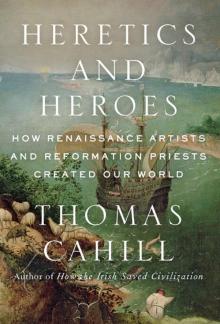 Heretics and Heroes
Heretics and Heroes Desire of the Everlasting Hills
Desire of the Everlasting Hills